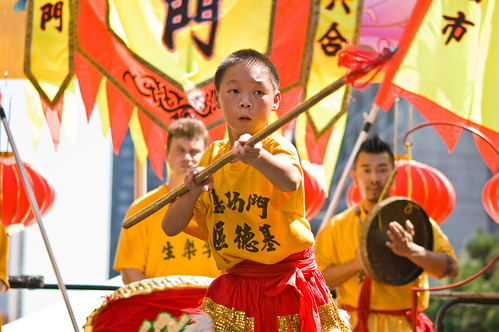It was a particularly warm day in San Francisco as the annual Chinatown moon festival was being held. It’s been awhile since I’ve gone shooting, and even longer since I’ve been to SF, so I thought it would be a good day for a trip. Since I was born and raised in NYC’s Chinatown, it’s good to see some things are still the same: the large crowds. Nothing like all the pushing and shoving to make you feel right at home. (Be careful with the little old ladies — they’re the most dangerous).
Besides the huge crowds, there’s also some great entertainment as well. Live singing, lion dances, and martial arts are just some of the festivities. Of course, having grew up in Chinatown, I’ve seen it all before. But this time it’s different. This time it’s behind the camera.
I got a great spot to watch the show. Front row seats, with plenty of space so I’m not elbow to elbow with the rest of the crowd. That’s because I’m actually standing right in the afternoon sun. So while everyone is watching the show in the cool shade, the few photographers among us were front and center in the sun. I guess it’s the price you have to pay to get the shot. But hey, I’m not complaining. Honestly, I didn’t even realize how hot it was under about 400 shots later, when I felt my camera being a bit warm, and my bare arms were getting pinkish from the sunburn. (I’ll remember to wear sunblock next time)
I wound up using the 75-150mm f/3.5 Series E lens mostly for the versatility of the zoom. It has a great reputation and it didn’t disappoint. After reviewing the shots, I found a few keepers, but also found a couple things I should’ve done differently:
- Learn to use fill flash. It was the middle of the day, so the sun was casting some harsh shadows. Also, the light was coming from the side which made the faces pretty dark. Then there was that white tent in the background which definitely meant blown highlights. All I had was the pop-up flash, but I need to start learning how to use fill flash so I can illuminate the face without over-exposing the rest of the image.
- Get closer. There were too many distracting elements in the scene. Getting a full body shot would mean having other unwanted objects in the frame as well. There were speakers, metal structures that were just getting in the way. I find the most pleasing shots I had were actually fairly close and above and waist. Plus, using the longer focal length gave me better subject isolation and apparent depth of field.
- Time the shot. The D40’s 3fps continuous mode isn’t fast enough to freeze the action that really captures the essence of the martial arts. You want to capture that kick as its fully extended, not while the leg is retracting. Too many of my shots were of the martial artist’s backside, which shows nothing interesting. I need to learn to anticipate the move. Part of this is understanding the sport or action that you’re shooting. I guess I need to watch my kung fu movies.
Thanks to the Yau Kung Moon Lion & Martial Arts Group, I got a few nice photographs of martial arts in action. I’ve always wanted to learn martial arts when I was a kid. The foam nun-chucks which I use to I smack myself around with every now and then are still in my room. And even if I don’t know kung fu, I can still appreciate its art form through photography.


 Posts
Posts